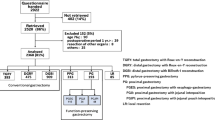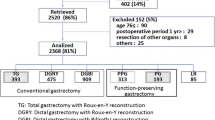Abstract
Background
Proximal gastrectomy with esophagogastrostomy (PGEG) has been widely applied as a comparatively simple method. In this study, we used a questionnaire survey to evaluate the influence of various surgical factors on post-operative quality of life (QOL) after PGEG.
Methods
In this post-gastrectomy syndrome assessment study, we analyzed QOL in 2,368 cases. Among these, 193 had undergone proximal gastrectomy and 115 had undergone PGEG. The Post-Gastrectomy Syndrome Assessment Scale (PGSAS)-45 is a questionnaire consisting of 45 items, including the SF-8, the Gastrointestinal Symptom Rating Scale (GSRS), and other symptom items seemed to be specific to post-gastrectomy. The 23 symptom items were composed of seven symptom subscales (SS), including esophageal reflux, abdominal pain, and meal-related distress. These seven SS, total symptom score, ingested amount of food per meal, necessity for additional meals, quality of ingestion SS, ability to work, dissatisfaction with symptoms, dissatisfaction with the meal, dissatisfaction with working, dissatisfaction with daily life SS and change in body weight were evaluated as main outcome measures. In PGEG cases, we evaluated the influence on QOL of various surgical factors, such as procedures to prevent gastroesophageal regurgitation and size of the remnant stomach.
Results
The scores for esophageal reflux and dissatisfaction with the meal were higher in patients who had not undergone an anti-reflux procedure. In most cases, the preserved remnant stomach was more than two-thirds the size of the pre-operative stomach. When comparing patients with a remnant stomach two-thirds the pre-operative size and those with more than three-quarters, the diarrhea SS and necessity for additional meals scores were lower in the group with more than three-quarters. The indigestion, constipation, and abdominal pain subscales, and the total symptom score, were higher in patients who had not undergone pyloric bougie than in those who had.
Conclusion
These results indicated that QOL was better in patients with a large remnant stomach. Procedures to prevent gastroesophageal reflux, and the use of pyloric bougie as a complementary drainage procedure, were considered effective ways to reduce the deterioration of QOL.

Similar content being viewed by others
References
Salvon-Harman JC, Cady B, Nikulasson S et al (1994) Shifting proportion of gastric adenocarcinomas. Arch Surg 129:381–389
Okabayashi T, Gotoda T, Kondo H et al (2000) Early carcinoma of the gastric cardia in Japan: is it different from that in the west? Cancer 89:2555–2559
Japanese Gastric Cancer Association (2011) Japanese gastric cancer treatment guidelines 2010 (ver. 3). Gastric Cancer 14(2):113–123
Sun Y, Yang Y (2011) Study for the quality of life following total gastrectomy of gastric carcinoma. Hepatogastroenterology 58:669–673
Kunisaki S, Akiyama H, Nomura M et al (2005) Surgical outcomes for early gastric cancer in the upper third of the stomach. J Am Coll Surg 200:15–19
Shiraishi N, Adachi Y, Kitano S et al (2002) Clinical outcome proximal versus total gastrectomy for proximal gastric cancer. World J Surg 26:1150–1154. doi:10.1007/s00268-002-6369-6
Katai H, Morita S, Saka M et al (2010) Long-term outcome after proximal gastrectomy with jejunal interposition for suspected early cancer in the upper third of the stomach. Br J Surg 97:558–562
Kumagai K, Shimizu K, Yokoyama N et al (2012) Questionnaire survey regarding the current status and conventional issues concerning reconstruction after gastrectomy in Japan. Surg Today 42:411–418
Lei W, Xin-Zu C, Bin W et al (2012) Total vs. proximal gastrectomy for proximal gastric cancer: a systemic preview and meta-analysis. Hepatogastroenterology 59(114):633–640
Nakada K, Ikeda M, Takahashi M et al (2013) Development and validation of PGSAS-45, an Integrated Questionnaire to Assess Postgastrectomy Syndrome. Gastroenterology 144(5 Supple 1):S–1111
Turner-Bowker DM, Bayliss MS, Ware JE Jr et al (2003) Usefulness of the SF-8 Health Survey for comparing the impact of migraine and other conditions. Qual Life Res 12:1003–1012
Svedlund J, Sjodin I, Dotevall G (1988) GSRS: a clinical rating scale for gastrointestinal symptoms in patients with irritable bowel syndrome and peptic ulcer disease. Dig Dis Sci 33:129–134
Ichikawa D, Komatsu S, Okamoto K et al (2013) Evaluation of symptoms related to reflux esophagitis in patients with esophagogastrostomy after proximal gastrectomy. Langenbecks Arch Surg 398:697–701
Matsushiro T, Hariu T, Nagashima H et al (1986) Valvuloplasty plus fundoplasty to prevent esophageal regurgitation in esophagogastrostomy after proximal gastrectomy. Am J Surg 152:314–319
Nakane Y, Michiura T, Inoue K et al (2004) Role of pyloroplasty after proximal gastrectomy for cancer. Hepatogastroenterology 51:1867–1871
Velanovich V (2003) Esophagogastrostomy without pyloroplasty. Dis Esophagus 16:243–245
Tokunaga M, Hiki N, Ohyama S et al (2009) Effects of reconstruction methods on a patient’s quality of life after a proximal gastrectomy: subjective symptoms evaluation using questionnaire survey. Langenbecks Arch Surg 396:637–641
Yamashita Y, Hirai T, Mukaida H et al (1999) Finger bougie method compared with pyloroplasty in the gastric replacement of the esophagus. Surg Today 29:107–110
Kuwabara K, Matsuda S, Fushimi K et al (2012) Comparative study on the difference in functional outcomes at discharge between proximal and total gastrectomy. Case Rep Gastroenterol 6:400–409
Hai AA, Singh A, Mittal VK (1986) Closed pyloroduodenal digital dilatation as a complementary drainage procedure to truncal vagotomy. Int Surg 71(2):87–90
Conflict of interest
The authors have no conflicts of interest to declare.
Author information
Authors and Affiliations
Corresponding author
Rights and permissions
About this article
Cite this article
Inada, T., Yoshida, M., Ikeda, M. et al. Evaluation of QOL After Proximal Gastrectomy Using a Newly Developed Assessment Scale (PGSAS-45). World J Surg 38, 3152–3162 (2014). https://doi.org/10.1007/s00268-014-2712-y
Published:
Issue Date:
DOI: https://doi.org/10.1007/s00268-014-2712-y




